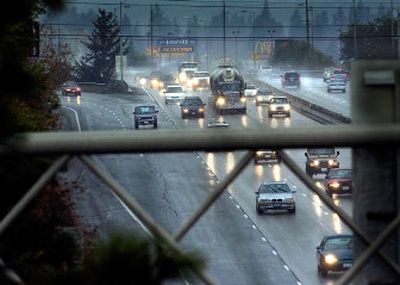Rough road ahead

Prepare yourself. Driving in downtown Spokane next year is going to be hairy.
Blame it on high traffic, blame it on studded snow tires, blame it on what you like: The Interstate 90 viaduct over downtown Spokane is a rutted mess. It will take the Washington State Department of Transportation two years and $15 million to fix the problem.
And it’s going to take the cooperation of local drivers to keep traffic flowing.
Transportation officials are beginning to circulate informational materials about the project and meet with neighboring businesses to explain the details.
Starting in May, one side of I-90 between Division and Maple will be closed for about three months, as crews work 24 hours a day, seven days a week to resurface the roadway. Two-way traffic will be maintained by squishing four lanes of traffic — two in each direction — onto the remaining side.
That’s down from the current three lanes traveling in each direction — lanes that carry a total of 90,000 vehicles a day.
The plan also calls for closing most downtown on- and off-ramps. Ramps will be completely closed at Lincoln and Monroe.
At the Division and Brown ramps, eastbound I-90 traffic will be able to enter the freeway, but not exit. Westbound traffic will be able to exit, but not enter the freeway.
At the Maple interchange, eastbound vehicles will be able to exit, but not enter the freeway. And westbound traffic will be able to enter but not exit the freeway.
Everything moves over to the other side of the freeway for the process to begin once again in summer 2007.
There will be no under-freeway parking during construction.
The only way gridlock can be prevented during the project is for local traffic to use alternate exits and surface roads, leaving the viaduct to through traffic, said Washington Transportation spokesman Al Gilson.
No short freeway hops downtown, and drivers bound for – or leaving – downtown should consider taking the Hamilton or Second Avenue ramps to avoid the construction area, Gilson explained.
That’s because traffic can’t back up at the exits like it does now at Division during many hours of the day, without clogging up the freeway.
“We need to get those local trips off of there,” Gilson said.
The state has been working with the city of Spokane, local businesses and hospitals near the affected area to come up with solutions for directing traffic.
“They said they would put up new signage for the hospital,” said Maureen Goins, spokeswoman for Sacred Heart Medical Center, located just south of the freeway project.
The department plans to install dozens of signs to direct drivers to and from the freeway and other destinations.
It’ll be up to each driver, though, to find some patience.